Comet ISON broke out, time to get binoculars
The astronomers community roars like a disturbed beehive — Comet ISON has flared. Until recently, she flew modestly toward the Sun, demonstrating brightness according to the most pessimistic forecasts. Its brightness slowly creeped up to 8 visible stellar magnitude (denoted as 8m). However, on November 15, an outbreak occurred, which raised the brilliance of the comet to the limits visible to the naked eye.
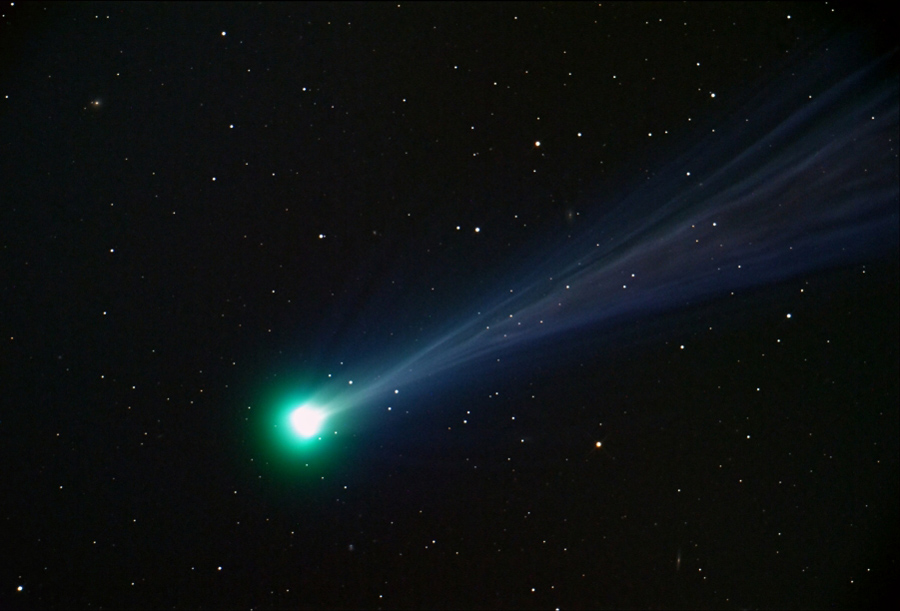
© John Nassr
November 15, talked about the brightness of 6m. The next day, observers, mostly amateur astronomers, started talking about brightness at 5m and even 4.6m.
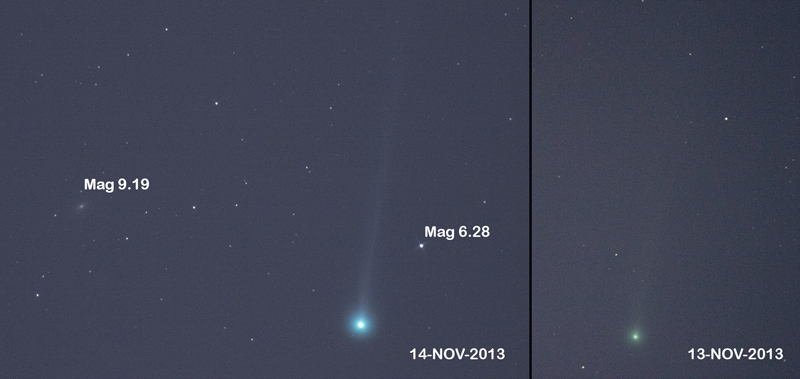
© Charles Coburn
')
6m is the minimum limit of visibility in a clear sky with almost no light from the ground. It should be noted that the apparent magnitude is logarithmic, and the difference between each unit is about 2.5 times. A step of 5 units gives a gloss difference of 100 times. Those. in two days the comet, having stepped from 8m to 5m, became brighter about 15 times.

The apparent magnitude of 5 units means that you can try to see the comet already in the sky of Moscow region or from medium-sized cities. True, a comet is a “smeared” (diffuse) object, so its brightness does not concentrate at one point, like that of a star, but is distributed throughout the area, so it’s better, nevertheless, to go somewhere without smog and bright lanterns in the area.
For example: a map of illumination around Moscow. Red color means visibility of stars up to 6th magnitude, but it is more difficult to notice a comet.

Read more about the map .
However, ISON is a morning comet, so you can try to consider it when the lights have already been turned off.
A photo with a shutter speed will allow you to see a comet even in those conditions when it is not visible to the eyes. True, shooting from the city, at best, will give something like this:

Those. you can see the comet itself, but you can forget about the chic tail.
Search for a comet should be on the horizon in the southeast, a couple of hours before sunrise. Every day it will become brighter, but at the same time, closer to the Sun, so it will be more difficult and more difficult to observe.
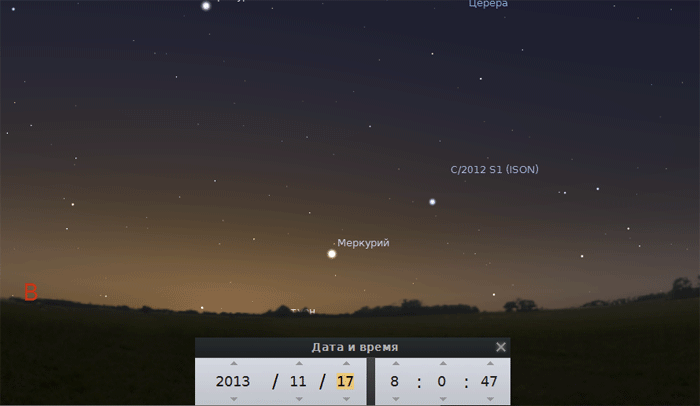
Before the comet approaches the Sun, we have only a few days, so it's time to look for good optics and recall the spells that disperse the clouds. November, of course, is not the best time for astronomical observations from our latitudes.
A few words about what means can be observed.
If the capabilities of the naked eye are not satisfied, it is worth something to arm. Any optical devices that allow you to bring distant objects near you are suitable: binoculars, telescopes, telescopes. For photography, you can use any cameras that allow you to adjust the exposure time with any lenses. Cameras will require a tripod. And, if you decide on an astrophotoshow, then dress warmer, my March experience with comet Panstarrs says that you have to spend three or more hours in one place.
It is also worth recalling that a lot of all comet-like flies in the sky, so do not confuse:

The comet moves much slower than the planes, it is singular and green. It is best to shoot the sky on a wide-angle lens at about the same time interval, then you can easily distinguish one from the other: the planes will quickly disappear from view, and the comet moves synchronously with the stars.
Based on the comet's trajectory, it will have a longer period of visibility after moving away from the Sun, when it approaches the Earth ( Calmly! Will not fall! ). True, there is one important “but”: but if the comet survives a close encounter with the Sun.
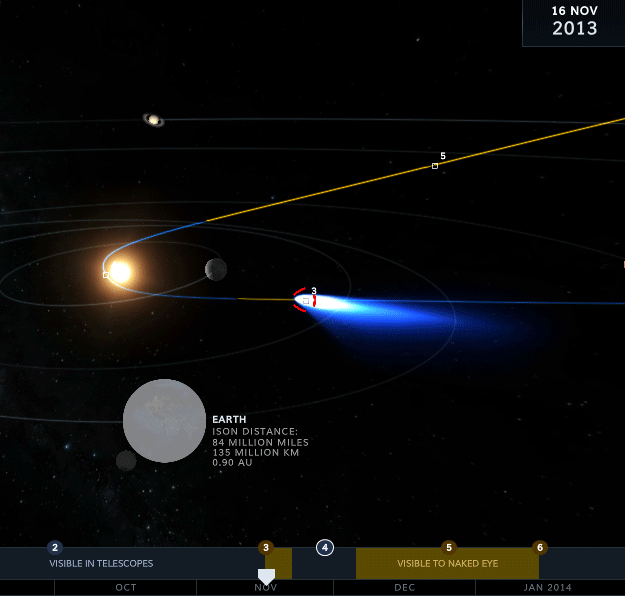
There are well-founded fears that the Sun will destroy the comet and, at best, we will see a flock of small debris, and at worst a barely noticeable cloud, like the one that comet Elenin has turned into.
Those who lack the patience to wait for good weather, and watch the comet in the morning with binoculars in their hands, can follow it through pictures that are regularly laid out on the website of astrophotographers, or on Twitter dedicated to the comet. During close encounters with the Sun, NASA's solar telescopes will observe the comet: STEREO, SOHO, SDO. Their pictures can be obtained on sites or look at helioviewer.org .
As an alternative, you can use the offer of remote telescopes , which BarsMonster recently talked about . Now is the right time for them.
Let us hope that the comet will survive a meeting with our luminary, will not fade away immediately after the flight, and in December the skies will give us at least a few good days for observation.
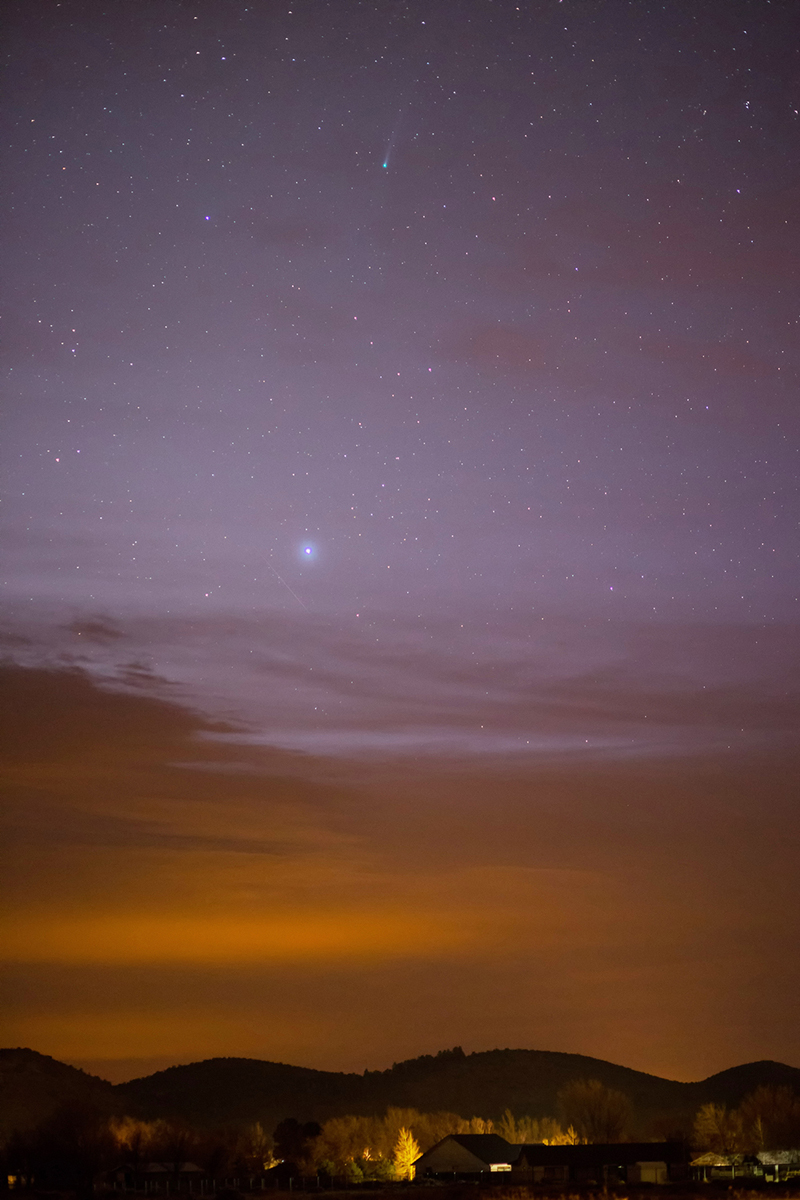
(c) Brian A. Klimowski
Thanks astronom for help in preparing the material.

© John Nassr
November 15, talked about the brightness of 6m. The next day, observers, mostly amateur astronomers, started talking about brightness at 5m and even 4.6m.

© Charles Coburn
')
6m is the minimum limit of visibility in a clear sky with almost no light from the ground. It should be noted that the apparent magnitude is logarithmic, and the difference between each unit is about 2.5 times. A step of 5 units gives a gloss difference of 100 times. Those. in two days the comet, having stepped from 8m to 5m, became brighter about 15 times.

The apparent magnitude of 5 units means that you can try to see the comet already in the sky of Moscow region or from medium-sized cities. True, a comet is a “smeared” (diffuse) object, so its brightness does not concentrate at one point, like that of a star, but is distributed throughout the area, so it’s better, nevertheless, to go somewhere without smog and bright lanterns in the area.
For example: a map of illumination around Moscow. Red color means visibility of stars up to 6th magnitude, but it is more difficult to notice a comet.

Read more about the map .
However, ISON is a morning comet, so you can try to consider it when the lights have already been turned off.
A photo with a shutter speed will allow you to see a comet even in those conditions when it is not visible to the eyes. True, shooting from the city, at best, will give something like this:

Those. you can see the comet itself, but you can forget about the chic tail.
Search for a comet should be on the horizon in the southeast, a couple of hours before sunrise. Every day it will become brighter, but at the same time, closer to the Sun, so it will be more difficult and more difficult to observe.

Before the comet approaches the Sun, we have only a few days, so it's time to look for good optics and recall the spells that disperse the clouds. November, of course, is not the best time for astronomical observations from our latitudes.
A few words about what means can be observed.
If the capabilities of the naked eye are not satisfied, it is worth something to arm. Any optical devices that allow you to bring distant objects near you are suitable: binoculars, telescopes, telescopes. For photography, you can use any cameras that allow you to adjust the exposure time with any lenses. Cameras will require a tripod. And, if you decide on an astrophotoshow, then dress warmer, my March experience with comet Panstarrs says that you have to spend three or more hours in one place.
It is also worth recalling that a lot of all comet-like flies in the sky, so do not confuse:

The comet moves much slower than the planes, it is singular and green. It is best to shoot the sky on a wide-angle lens at about the same time interval, then you can easily distinguish one from the other: the planes will quickly disappear from view, and the comet moves synchronously with the stars.
Based on the comet's trajectory, it will have a longer period of visibility after moving away from the Sun, when it approaches the Earth ( Calmly! Will not fall! ). True, there is one important “but”: but if the comet survives a close encounter with the Sun.

There are well-founded fears that the Sun will destroy the comet and, at best, we will see a flock of small debris, and at worst a barely noticeable cloud, like the one that comet Elenin has turned into.
Those who lack the patience to wait for good weather, and watch the comet in the morning with binoculars in their hands, can follow it through pictures that are regularly laid out on the website of astrophotographers, or on Twitter dedicated to the comet. During close encounters with the Sun, NASA's solar telescopes will observe the comet: STEREO, SOHO, SDO. Their pictures can be obtained on sites or look at helioviewer.org .
As an alternative, you can use the offer of remote telescopes , which BarsMonster recently talked about . Now is the right time for them.
Let us hope that the comet will survive a meeting with our luminary, will not fade away immediately after the flight, and in December the skies will give us at least a few good days for observation.

(c) Brian A. Klimowski
Thanks astronom for help in preparing the material.
Source: https://habr.com/ru/post/202362/
All Articles